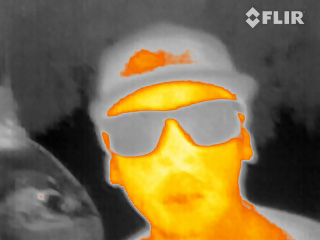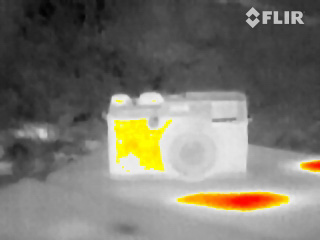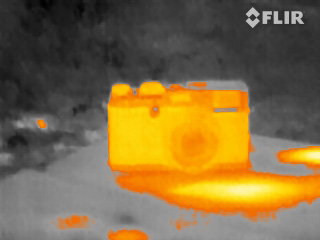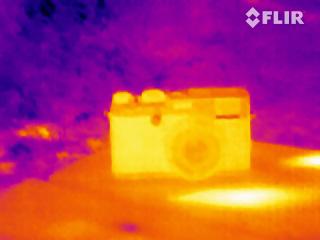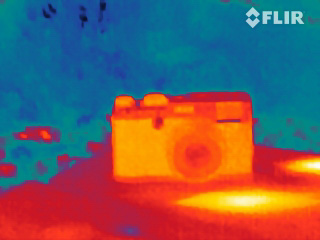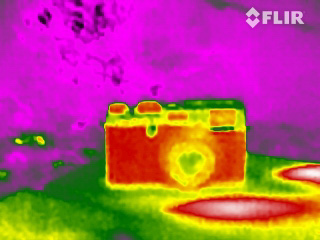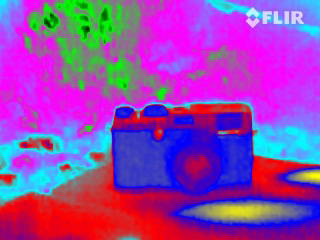The Scout TK brings most of the functionality of a high-end thermal monocular to a friendlier price point.
Other than in the video game Tom Clancy’s Splinter Cell, thermal vision is not something I have any experience with. So when I picked up FLIR’s newest entry-level thermal imager, the Scout TK, I was a little unsure how best to go about testing it. After all, I don’t spend my time in real life sneaking around at night, trying to steal sensitive documents from behind the backs of watchful mercenaries. As it turns out, though, there is a surprisingly long list of things thermal vision is good for, even if not all of them are quite as exciting as being an international super spy.
As FLIR’s entry-level monocular, the Scout TK is built with simplicity in mind. It’s incredibly easy to use, with just four buttons for power, screen brightness, camera, and color palette. Users can select from nine palettes that change how the Scout TK displays heat information, including White Hot, Black Hot, and various other options that highlight hot subjects with different colors. A single press of the camera button takes a picture, while holding the button briefly will start recording a video, both of which are stored to internal memory. Files can be transferred to a computer over USB.
The obvious applications for such a device include hunting and backpacking. Whether scanning for a target or a potential threat (or if you just want to see what’s out there), a thermal imager is an indispensable aid. Human eyes are sensitive to motion, but an animal standing still will blend in with its environment and become almost invisible to the naked eye. This is especially true at night or in low light, and this is where a thermal imager becomes invaluable.
Like FLIR’s other outdoor-oriented monoculars, the Scout TK is sealed against dust and moisture, so it can be used in any environment. Again, I don’t have much experience with such devices, but the Scout TK feels very well made; I have no doubt it will survive being banged around at the bottom of a backpack. Its five hour batter life should also be sufficient for any overnight excursion, although it can be charged over USB if needed.
Everyday items suddenly become curiosities when our eyes are opened up to the infrared spectrum.
But there are other, less obvious uses for a thermal imager. As my first time seeing with infrared vision, I found the experience to be unexpectedly exciting. There are so many everyday things that we wouldn’t give a second thought to, suddenly become curiosities when our eyes are opened up to the infrared spectrum. For example, I have several dead electrical outlets in my office that glow bright when viewed through the Scout TK. A live outlet, on the other hand, doesn’t glow at all. I have no idea why this is, but perhaps I should call an electrician?
I also used the Scout TK to detect what I can only assume is a heat leak in my home, showing up as a bright glowing area along part of the seam where one wall meets the ceiling. I also discovered that thermal vision doesn’t work through glass, although my own infrared reflection showed up quite well (maybe to do with heat-reflecting coatings on the windows?). I found myself pointing the device at just about everything, just to see what I could see: an external hard drive, wireless router, air conditioning vent. It shouldn’t have been this exciting, and yet it was.
There are, of course, more serious uses for the device. FLIR advertises it as both a home and mobile security solution, and this is a point worth emphasizing. If you’ve ever had to walk to your car in the dark after a long day at the office, the Scout TK could bring some peace of mind. A quick infrared scan of the parking lot will reveal anyone in the vicinity (although, keep in mind, infrared vision is not the same as x-ray vision – someone hiding behind a wall won’t be visible). The Scout TK has an effective range of 100 yards, so you can survey an area from a safe distance. At four inches long and just six ounces, it is also small and light enough to easily stow away in a purse, messenger bag, etc.
At $600, the Scout TK is not exactly an impulse buy. It’s a niche product, but well worth the investment for those who could really benefit from it. And compared to other thermal imagers, the price is actually quite low. Even within the Scout series, FLIR makes monoculars costing as much as $3,400, but these offer more features, higher resolution, and faster refresh rates compared to the Scout TK.
As much as I enjoyed playing around with the Scout TK, it may not be the best choice for someone simply looking to have fun with thermal vision. The FLIR ONE for iOS and Android is probably the better option here, as it is just $249 (and surprisingly feature rich). The Scout TK, however, brings most of the serious functionality of a high-end thermal monocular to a much friendlier price point. It is a capable device, will hold up in any environment over long periods of time, and may even provide puzzling insight into how your house is wired.
Highs
- Great build quality
- Relatively inexpensive
- Fun and easy to use
- Good battery life
Lows
- Low resolution
- Price will still limit appeal


